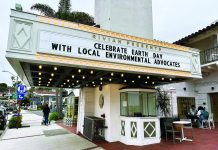City Council to review Downtown Specific Plan next month
By Allison Jarrell | LB Indy
After a third review of the final draft of the Downtown Specific Plan (DSP)—a document that outlines the city’s vision for the future of downtown Laguna Beach—the Planning Commission decided unanimously Wednesday to recommend that the City Council approve the plan, as well as a negative declaration stating that the plan will not have adverse environmental impacts.
After hearing input on the 170-page document from about 30 residents, Planning Commission members voted 4-0 to pass the document on to the Council, along with a few corrections and clarifications that came up during public comment. Planning Commissioner Steven Goldman was absent.
The DSP is tentatively scheduled to be reviewed by the City Council at its Dec. 17 meeting.
Planning Commission Chairman Ken Sadler pointed out at the beginning of the meeting that the final draft of the DSP is the culmination of a five-year process that began with a pop-up outreach event on Ocean Avenue in November 2014. “This might be our 23rd meeting on the DSP. It’s been a long process,” Sadler said, adding that there have been a number of public outreach efforts since then. “I believe the Planning Commission has gone through all of these issues carefully.”
The aim of the DSP is to identify goals and establish policies, guidelines and standards to support an overall vision for the future of downtown Laguna Beach.
After hearing public input both for and against the revised document at previous meetings, the Planning Commission was tasked Wednesday with incorporating 13 amendments to the final document, and ultimately pass the plan on to the City Council for final consideration and approval
Senior Planner Wendy Jung reviewed the amendments with the commission, including a notable clarification that states parcels will not be “merged together for development purposes that exceed 5,000 square feet except for affordable housing projects for long-term, low-income residents, such as seniors, students, artists, and people with disabilities, when located on Broadway, in the Arts District, and in the CBD Office District, and for city-ownership projects, but developments may occur on existing parcels that are in excess of 5,000 square feet.”
The commission’s green light of the DSP was a decisive win for the local business owners who spoke at the meeting. Cary Redfearn, owner of the Lumberyard and Slice with his wife, Suzanne, said he’s in full support of the DSP—he hopes the new vision will help attract innovative retail, restaurant and mixed use businesses.
“Unfortunately, lately we’re seeing a decline. We’ve got restaurants, retail, hotels, and even a movie theater that now sit vacant,” Redfearn said. “We are losing the vitality we once had, and there are fewer compelling reasons for people to come to Laguna Beach.
“Our downtown needs to adapt to the challenges that we face,” Redfearn concluded. “The new DSP will make it easier for businesses to open, and I applaud that.”
Other business owners echoed Redfearn’s sentiments. Local lawyer Larry Nokes said he was in favor of the residential component downtown, adding that any short term lodging issues that arise could be dealt with. Chamber of Commerce officials voiced support for the DSP, as well as Tyler Russell, general manager of KX 93.5, who said the city’s priority should be bringing new types of businesses to the vacant downtown storefronts.
LCAD student Madison Andrews said she thinks the DSP will bring much needed affordable housing downtown and revitalize student life in Laguna.
Among those opposing aspects of the revised DSP were members of the Village Laguna board of directors, some of whom took turns reading from a prepared statement. They took issue with specific policy changes regarding: the new height limit, allowing lot consolidations of more than 5,000 square feet on Broadway and in the Arts and Office districts, the nonconforming building height standard, flexibility in the permit process, parking, historic preservation, and urban design guidelines.
Village Laguna members argued that changes, such as the proposal to allow new second stories downtown, violate the objectives of keeping downtown small-scale and pedestrian-friendly.
“There’s no evidence that residents are interested in seeing more housing downtown, that there is any need for it (given the existing 400-some residential units), or that more housing would revitalize downtown business,” said Johanna Felder, Village Laguna president. “What the Housing Element of the General Plan appears to be most concerned about is overpayment for housing, and adding second stories downtown without restricting them to affordable housing might make things worse, given that short-term rentals are so profitable and are allowed in nearly all the downtown zones.”
After commissioners discussed public testimony with Director of Community Development Greg Pfost, they decided to push the final document forward with a few edits, as well as some alternatives to certain policies for the Council to consider, such as allowing market rate housing and/or mixed uses along with affordable housing in the second stories of downtown buildings.
“I think the plan achieves a balance between preserving the scale of the downtown, what we think is important about the downtown, and creating a vision for the future,” said Commissioner Susan McLintock Whitin. “I believe right now we really need some change. We need a dynamic and active town year round, not just on summer weekends or summer days.”
Pfost said all public comments on the DSP and the environmental study will be addressed with responses from city staff. The City Council will then take that information into consideration and will need to decide whether to certify the negative declaration and approve the DSP.
For more information or to view a copy of the Downtown Specific Plan, visit lagunabeachcity.net/civicax/filebank/blobdload.aspx?blobid=23477 or contact Senior Planner Wendy Jung at (949) 497-0321 or [email protected].





Clearly, residents do not agree with the Planning Commission’s decisions regarding all of the changes proposed for the Downtown Specific Plan. The Indy’s own weekly polling question in November asks:
“Should the final draft of the Downtown Specific Plan be approved by the City Council in December?”
RESULTS:
No, the DSP needs more work and revisions (79.17%)
Yes, the DASP should be approved as is. (16.67%)
Yes, the DSP should be approved, but with minor changes. (4.17%)
The City Council should listen to their constituents! They should spend as much time as necessary to explore what the major changes (combining lots, height and parking changes, others) “will” and “will not do” to our city. Several changes to the DSP may promote long-term negative impacts. The City Council needs to educate the public on the NEED for the proposed changes for our town before considering final approval. Send the CC your thoughts on this issue. Ask for a designated CC meeting to review details and flush out the public”s concerns before any voting takes place. And by all means, confirm that ANY CC member who will benefit directly (like DSP change promoter Peter Blake) be recused from voting on this matter. The “CHANGE” movement is important to our City’s future. We must not get so wrapped up in the movement (credit to developers/downtown businesses) that we make serious or flawed infrastructure mistakes.